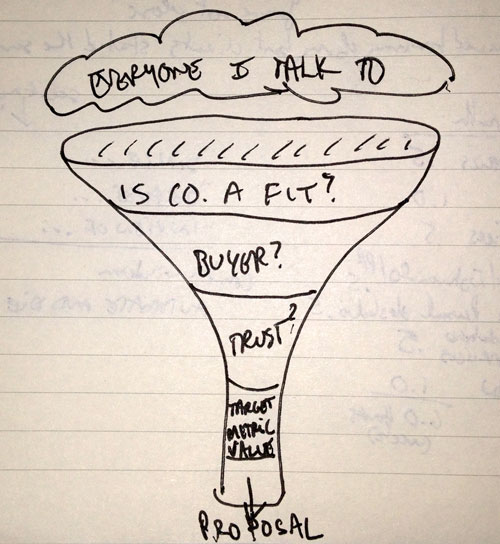Decision Making and New Business Project Proposals
Decision Making and New Business Project Proposals
How can you make sure you win more proposals? Take a hint from Roger Hornsby and make sure you’re setting yourself up for success.
As he so astutely put it, “The first rule of baseball is to get a good ball to hit.”
I’ve answered a lot of questions about how my first year of solo-consulting went like when one of my sales training friends asked what my closing percentage on proposals is. That’s the inspiration for today’s thoughts about decision making and new business project proposals.
First up are some definitions. When I talk about project proposals, I’m referring to the written document presented to a potential client outlining my recommended course of action. I’ve discussed the rough outline I follow here: Writing a Project Proposal Outline. It marks the end of the prospecting process and the beginning of the engagement process.
When my friend asked me what my closing percentage was, I was almost embarrassed to say “70+%”.
Why is that embarrassing? Because in my background as a sales manager I used to routinely chastise reps for having closing ratios in excess of 50%. It meant they weren’t presenting enough. I know that it isn’t a fair comparison because my sales force usually sold into our excess capacity and I am selling my brain and time (insert wisecrack here) which is not a limitless resource! Still, even with that in mind, the question was how does a 70%+ closing ratio happen?
It’s simple: I only submitted written proposals when I had a “good ball to hit”.
That led to the discussion about my sales cycle/defining a good ball and my standard graphic representation of the Chambers Pivot sales process:
Yep. Chicken scratch. Check the detailed description here: My Consulting Sales Process Cheatsheet
The magic in the close ratio happens between the Trust stage and the Proposal stage. That’s where we talk numbers, measures and dollars of the client. I have learned that if we can’t talk about those things in detail, I shouldn’t bid on the project.
Did I make that sound too simple? Maybe I should make up a complicated equation:
CPBA = (2T + (t+m+v) * B) + F
or Chance of Proposal Being Accepted = (2 times Trust plus (defined target+usable metrics+agreed on value) times is this a Buyer) all added to “is the company a Fit”.
Does that look right?
Wilson the ABC says yes. (amazing border collie)
That’s how you make sure you have a good ball to hit and win more new business project proposals.
Good stuff.
About the Author: Greg Chambers is Chambers Pivot Industries. Get more business development ideas from Greg on Twitter.


